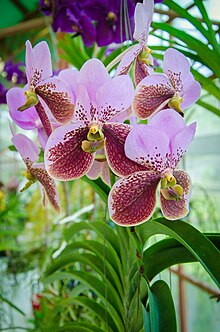Vanda sanderiana is a species of orchid. It is commonly called Waling-waling[2] in the Philippines and is also called Sander's Vanda,[3] after Henry Frederick Conrad Sander, a noted orchidologist. The orchid is considered to be the "Queen of Philippine flowers" and is worshiped as a diwata by the indigenous Bagobo people.
| Vanda sanderiana | |
|---|---|

| |
| flower detail | |
| Scientific classification | |
| Kingdom: | Plantae |
| Clade: | Tracheophytes |
| Clade: | Angiosperms |
| Clade: | Monocots |
| Order: | Asparagales |
| Family: | Orchidaceae |
| Subfamily: | Epidendroideae |
| Genus: | Vanda |
| Species: |
V. sanderiana
|
| Binomial name | |
| Vanda sanderiana (Rchb.f.) Rchb.f.[1] | |

| |
| distribution of Vanda sanderiana | |
| Synonyms[1] | |
| |

Heinrich Gustav Reichenbach named it as Vanda sanderiana.
It has two forms, pink and white, also referred to as alba. M. Roebelin discovered the original pink variety in the Philippines in 1881 or 1882. Rudolf Schlechter separated Euanthe from Vanda in 1914 due to structural differences in the flowers.[4] For breeding purposes and registration by the Royal Horticultural Society, however, it is still treated as a Vanda.[5]
Vanda sanderiana is endemic to Mindanao in the provinces of Davao, Cotabato, and Zamboanga where it is found on the trunks of dipterocarp trees at elevations below 500 meters. Over-collected, the plant is considered rare in nature. It is often used in hybridization.[6]
Studies have shown that when raised at high altitude, the plant bears flowers early.
In 2004, a motion was filed in the House of Representatives of the Philippines to declare the Waling-waling as the country's national flower, replacing the Sampaguita.[7][8]
In 2013, a bill was passed by the Philippine Senate declaring the Waling-waling as a national flower alongside the Sampaguita.[9] However, the House Bill 5655 was vetoed by President Benigno Aquino III citing that other means were available to promote the protection and preservation of the orchid without declaring it a second national flower.[10]
The Philippine Orchid Society, which incorporates an image of the flower in its logo, states that the species has three varieties:[11]
a second national flower has the pernicious effect of creating confusion in the minds of the public and the academe. Moreover, declaring the Waling Waling Orchid as the second national flower would have the effect of displacing the hallowed status of the Sampaguita, a cherished national icon, as the primary symbol of Philippine culture and artistry. Furthermore, there are other means to promote the protection and preservation of the Waling Waling Orchid without declaring it a second national flower.